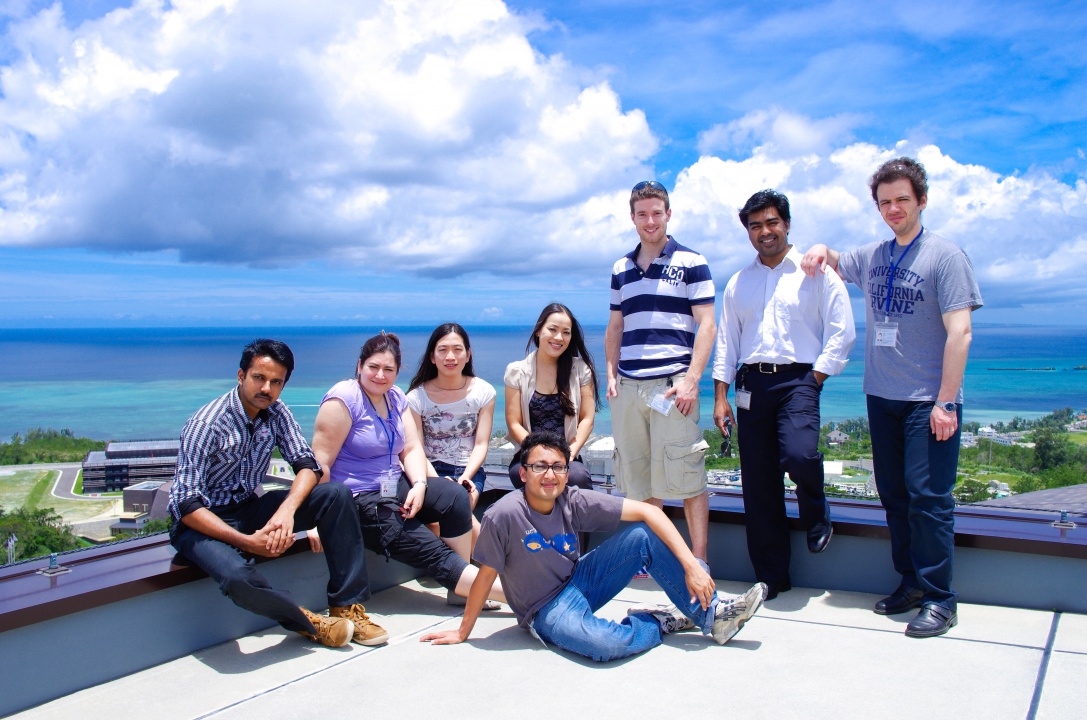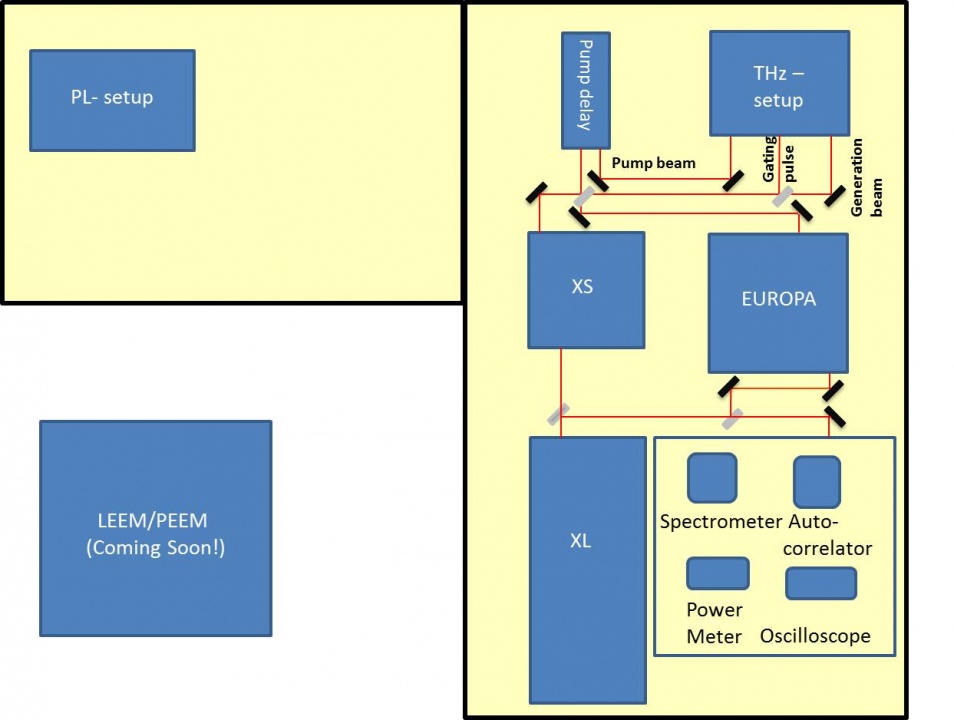FY2011 Annual Report
Femtosecond Spectroscopy Unit
Professor Keshav Dani

Abstract
In recent years, the ability to synthesize, engineer & observe materials on the nanometer length scale has led to novel phenomena and applications. On the other hand, modern lasers deliver powerful, ultra short pulses of light allowing us to observe the interaction of electrons and atoms on the femtosecond timescale. Together, these technologies allow us to study new paradigms in light-matter interaction – with femtosecond temporal resolution and nanometer spatial resolution. In FY2011 in the Femtosecond Spectroscopy Unit, we have directed these abilities towards two areas of study – (a) Metamaterials & Plasmonics, where artificially nano-engineered materials promise energy-efficient ultrafast photonic devices; and (b) Novel 2-dimensional Materials, where new materials like graphene (a semi-metal with zero bandgap, massless electrons) and hexagonal Boron Nitride (an insulator with a bandgap in the UV) lead to intriguing opto-electronic properties.
1. Staff
- Dr. Julien Madéo, Post-doctoral researcher
- Catherine Chin, Graduate research assistant
- Rakesh Parayil Parameswaran Nair, Graduate research assistant
- Yoko Fujitomi, Research administrator
2. Collaborations
- Theme: Broadband Terahertz Time Domain Spectroscopy with Interdigitated Photoconductive Anetanneas
- Type of collaboration: Joint research
- Researchers:
- Dr. Sukhdeep Dhillon, Ecole Normale Superieure, Paris, France
- Professor Jerome Tignon, Ecole Normale Superieure, Paris, France
- Theme: Optical Properties of Graphene Quantum Dots
- Type of collaboration: Joint research
- Researchers:
- Professor P. Ajayan, Rice University, Houston, TX, USA
- Dr. Zheng Liu, Rice University, Houston, TX, USA
- Professor Carole Diederichs, Ecole Normal Supereiure, Paris, France
- Theme: Integrating Negative Index Metamaterials with Optical Fibers for Photonic Devices
- Type of collaboration: Joint research
- Researchers:
- Professor Ulrike Wogon, Technical University Berlin, Germany
- Yuecel Kaptan, Technical University Berlin, Germany
3. Activities and Findings
3.1 Development of a broadband Terahertz Time Domain Spectroscopic System
In order to study the optical properties of novel nanostructured materials, the Femtosecond Spectroscopy Unit initiated development of the Microscopy Lab in Nov. 2011.

FIGURE 1
As shown in figure 1, a commercial, high power, high repitition rate, Ti:Sapphire oscillator system (XL) delivers 40fs, 650nJ, 800nm pulses. With the use of a commercial short pulse kit (XS), we then broaden the spectra of the Ti:Sapphire laser through an optical fiber with roughly 60% conversion efficiency. The output of the XS is recompressed to sub 15fs pulses with 350nJ of output energy at 4MHz.
These sub-15 fs pulses are then directed into a home built Terahertz (THz) Time Domain Spectroscopic (TDS) system to produce broadband THz pulses. The homebuilt THz-TDS system consists of an inter-digitated GaAs photoconductive antenna with a high bias voltage applied across the antenna. The sub-15fs pulses incident on the antenna generate fast photocarriers which are accelerated in the applied bias voltage. The accelerating charges generates an electric field in the THz as per Maxwell's Equations. Large parabolic gold mirrors then collect the emitted THz field, focus it on the sample and then recollect the transmitted (or reflected) THz filed, which is again focussed onto a thin ZnTe or GaP crystal. The THz field is measured via electro-optic sampling in these nonlinear crystals. Figure 2 shows a plot of a typical single cycle THz pulse generated in our experimental setup, along with the corresponding fourier transformed spectrum.

FIGURE 2
Current efforts are underway to characterize the THz pulses for different input pulse energies on the photoconductive antenna, different detection crystals and different antennae substrates.
3.2 Optical properties of graphene nanostructures
In collaboration with Prof. Ajayan at Rice University, (Houston, USA) and Prof. Carole Diedrich at Ecole Normal Superieure (Paris, France), the Femtosecond Spectroscopy Unit initiated the study the optical properties of graphene nanostructures in the visible and near-IR.
The graphene quantum dots were prepared at Rice University by sonication of carbon fibers with concentrated H2SO4 and HNO3 at various temperatures to produce dots of difference size distributions in the range of a few nanometers.
The solution of graphene quantum dots were then deposited onto SiO2 substrates for AFM measurements on the height/size distribution of the quantum dots; and on quartz substrates for Photoluminescence measurements.
The graphene quantum dots demonstrated photoluminescence in the Visible and NIR spectrum, however consistent measurements were hard to obtain due to aggregation of the quantum dots.
Currently, efforts are underway to prepare new samples, while avoiding the aggregation of the dots over long periods. Efforts are also underway to apply the recently developed THz TDS Setup (See 3.1) towards understanding the properties of graphene quantum dots in the low energy THz range.
3.3 Metamaterial photonic devices integrated with optical fibers
Extending on previous work in the fabrication of an ultrafast metamaterial device, the Femtosecond Spectroscopy Unit initiated the fabrication of metamaterial devices integrated with optical fibers with the Technical University of Berlin. Previous efforts had demonstrated the ability of a fishnet structure metamaterial device to function as a sub-picosecond all-optical modulator.
In collaboration with TU Berlin, the Femtosecond Spectroscopy Unit has started attempts to fabricate the metamaterial structure on an optical fiber that can then be seamlessly integrated into a variety of future photonic devices.
The fabrication of the device on a fiber remains a challenge due to the diameter of the fiber (9um); difficulties in combining various fabrication techniques - i.e. deposition of amorphous silicon and metallic layers on the fiber; and the patterning of the 2D periodic array of holes required for the device.
Current efforts are underway to resolve these issues and characterize the grown structures.
4. Publications
4.1 Journals
- S. Gilbertson, G. L. Dakovski, T. Durakiewics, J. Zhu, K. M. Dani, A. D. Mohite, A. M. Dattelbaum & G. Rodriguez. Tracing ultrafast separation and coalescence of carriers in graphene with time-resolved photoemission. J. of Phys. Chemistry Lett. 3, 64-68 (2012)
4.2 Books and other one-time publications
Nothing to report
4.3 Oral and Poster Presentations
Nothing to report
5. Intellectual Property Rights and Other Specific Achievements
Nothing to report
6. Meetings and Events
6.1 Research Visit
- Dr. Rishi Sharma, TRIUMF, Vancouver, Canada
6.2 Seminar
- K. M. Dani, Femtosecond Spectroscopy of Novel Materials, Seminar, Univ. of Kyoto, Kyoto, Japan, December, 2011
- K. M. Dani, Ultrafast Metamaterial Devices and Relativisitc Dynamics in Graphene, Seminar, Technical Universitat, Berlin, Germany, January 2012
- K. M. Dani, Ultrafast Spectroscopy of Nanoscale Structures, Seminar, Univ. of Kyoto, Kyoto, Japan, March 2012
7. Other
Nothing to report.



